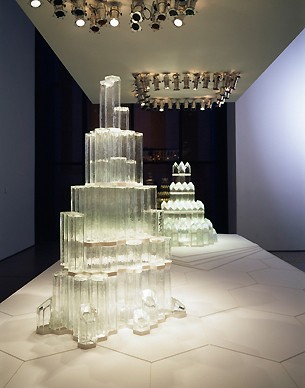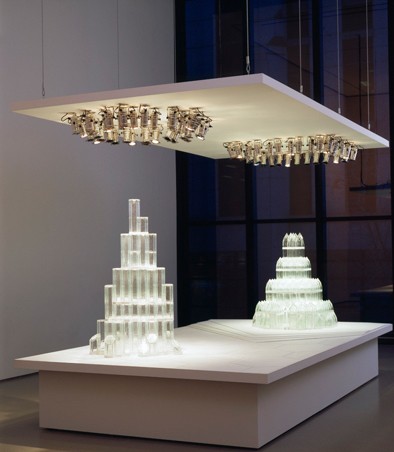
Josiah McElheny, The Alp Cathedral and The City-Crown, 2007 Courtesy Donald Young Gallery, Chicago; Andrea Rosen Gallery, New York. Installation commissioned by the Museum of Modern Art, New York.
The Alpine Cathedral and The City-Crown
According to Scheerbart, glass possesses spiritual qualities that would transform and reform humanity. Based on the ideas of an animated universe, Taut believed that architecture had the ability to heal and improve mankind. In their utopian world, glass towers would crown mountain tops and the central building in every city, spreading the light of higher understanding.
In The Metal Party, 2001, in which McElheny reconstructed a party held at the Bauhaus in Dessau in 1929, people were constantly reflecting themselves in the mirror decorations and in each other’s metal dresses. Mirror reflections appear here as a metaphor for intellectual reflection, be it self-reflection or reflection about others and the world, as an essential part of the modernist project.
Josiah McElheny’s sculpture An End to Modernity, 2005, is a sculpture that echoes the design objects of the 1960s, specifically the chandeliers at the Metropolitan Opera House in New York. At the same time it is also a complex scientific model of the Big Bang, “a model of the beginning of time and an image of the universe,” as curator Helen Molesworth puts it.
The transparent material of glass is a metaphor for Modernism’s notion of intellectual transparency. The unpolished and imperfect surface of the glass buildings in The Alpine Cathedral and the City-Crown might suggest the impossibility of this and of realizing utopias. At the same time these aspirations are fascinating, inspiring and necessary.
In the presentation of its collection of the 20th century, Moderna Museet attempts to explore art history from a contemporary perspective. Since Josiah McElheny is doing this as an artist as well, he agreed to present his work not in a separate gallery, as he did in the Museum of Modern Art in New York earlier this year, but in dialogue with Moderna Museet’s early Modernist collection.
While the spiritual and occult undercurrents in Taut’s and Scheerbart’s visions are not shared by Russian constructivist Vladimir Tatlin (1885-1953), his model of a tower, Model for Monument for the 3rd International from 1919-20, was also an utopian architectural vision of a better and more harmonious world to be constructed on the basis of Communist ideas. At 400 metres, the tower would have been the tallest building in the world. The enormous construction of glass and steel, symbolizing strength and transparency, was never realized.
The abstraction in Russian Kazimir Malevich’s (1879-1935) suprematist paintings was a portal to the spiritual world. This became obvious when, in the 1915 0.10 exhibition in Petrograd, he presented his most famous painting Black Square in the corner of the exhibition hall, occupying the holy space of the Russian icon. Occultism and Spiritism were topics highly discussed in avant-garde circles at the turn of the 20th century.
Swedish artist Hilma af Klint’s (1862-1944) work can also be read as visions of a spiritual utopia in which the individual aims to achieve an understanding of the cosmic laws in order to create a better world by the means of art. Her earliest abstract paintings date from around 1906 and thus precede the abstraction achieved by artists like Kandinsky, Malevich and Mondrian, but according to Hilma af Klint they were not a result of a conscious intellectual path towards abstraction. She regarded her work as being transmitted by higher consciousnesses and her own role as that of a medium for messages from higher realms.
The considerable diversity in thought we encounter in the visionary attitudes of the first decades of the 20th century in this gallery, mirrors a very important aspect of McElheny’s artistic enterprise. His own artistic universe is an inclusive and generous one, embracing diversity of thought and feeling, inspiring the viewer to be open, curious and not judgemental.

